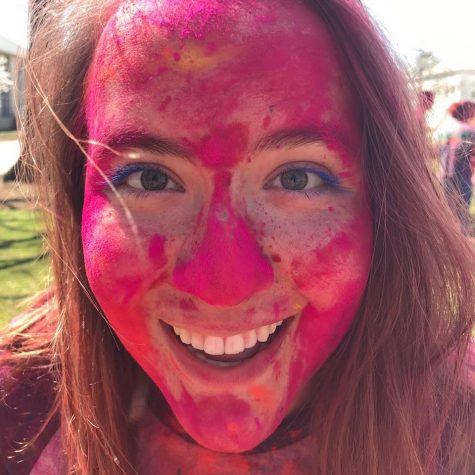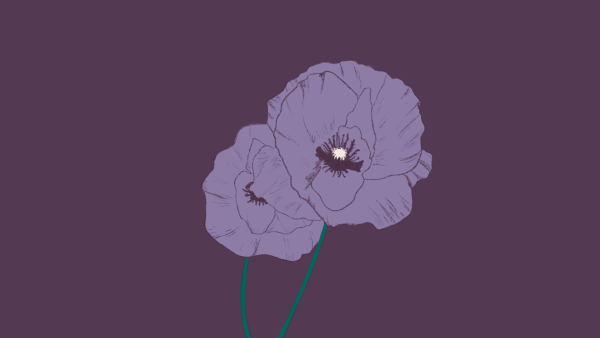“A platform for vulnerability”: A conversation with the creators of Lumxn
The founders of this women-of-color focused magazine, recently featured by the National Museum of Women in the Arts, on the process behind its creation and how they center authenticity in their publication.
Lumxn features the experiences of womxn of color in a raw light. The goal is to highlight people in different parts of their healing journeys through spotlighting their creative projects or telling their stories, and to add complexity to the narratives of WOC and healing.
Reina DuFore and Marlin Ramos launched Lumxn as seniors at American University in spring 2019, with help from the American University’s Women’s Initiative, which provided a grant for Print 1: “Beginnings.”
They received a second grant from the Washington Area Women’s Foundation for Print 2: “Memory,” and leftover funds from the WAWF are going towards the publication of Print 3, which will be released in 2021.
The magazine was spotlighted by the National Museum of Women in the Arts this year, and prints one and two are available for purchase in the museum’s gift shop. Located in Washington, the NMWA features rotating special exhibitions that showcase work by established and emerging women artists.
[This conversation has been condensed for clarity]
What inspired you to start Lumxn?
DuFore: Because we were on AU’s campus, we were seeing very traditional models of activism and feminism being portrayed. So as someone living on that campus and being susceptible to that environment, where it’s like you have to start a protest or an NGO to achieve this level of success, we really wanted to hear more from every-day, regular dope women. We like to say that we build community inside and outside of our pages where we really allow people to be their most vulnerable selves and that exists in a lot of different forms…It’s very different from student media, like we don’t go through with a red pen and fix grammar or verbiage. We really wanted to present the whole person to the reader so that they’re able to see that how you exist, and how you think, and how you speak, and how you write is valid and it’s valid for a publication.
We have art, we have poetry, we have think pieces, and one thing that I really love, that was actually Mars’ idea, is that we also feature people’s journal entries, and so that’s just really true to our mission of not really editing…because we think that the way you show up is valid enough. We really wanted to be pushing back against that prescriptive style of reporting and giving a more genuine and vulnerable look at life for women and especially women of color, because we’re women of color centered.
Ramos: Our three pillars are light, healing and being, and we thought it was really important to focus on this healing and being aspect because we want to be a publication for the people in the process, for the people who are not heal-“ed” but who are healing or asking some of these questions, who aren’t perfect.
How do you feel being a publication that centers women of color has impacted your internal community, in terms of the editors and contributors for Lumxn, and the external community of greater D.C. and its readers?
Ramos: I think that we give a platform for vulnerability, to kind of be seen by others. So, I think that our pages build community by allowing people to show their wounds on the pages and for others to be like “Damn, I’ve felt this way too before.” Outside of the pages, D.C. has been so vital to that. There’s been some events that we go to and we meet people, and these are the people who end up submitting something for our magazine or people who end up interviewing somebody. So, D.C. really has been pivotal to building Lumxn’s community.
DuFore: One thing that Mars and I talk a lot about is we have to live these principles of being and healing and light, and so I think that it’s both been such a meditative process for us just working on the magazine because we have to honor that. We have to honor the place of being that we try to have in our magazine and with ourselves, and so that’s allowing us to grow organically and allowing us to really just be where we are a publication as well. And because we are women of color and there are so many expectations put on us as women of color, it’s nice to have this safe space and this safe thing that we work on together for women of color that allows us to also be ourselves and be in the mindset that we’re currently in, whatever that is.
We had this one piece in our second issue, and when I read it, I was thinking, “Maybe I can edit this a little bit more.” But I just left it alone, and everybody tells us it’s their favorite piece in the whole magazine, and I think that that’s so descriptive of the type of publication that we’re trying to be. And people loved it, like they loved all of the twists and turns and that idea that the person who was just trying to process their feelings and so it made the reader feel less crazy about what they were feeling.
What was the experience of starting Lumxn like, i.e. getting the project off the ground, and any trials or tribulations or successes you experienced in the beginning phases of the magazine?
Ramos: We started on AU’s campus, and that was beautifully successful. Shoutout to Women’s Initiative for being so supportive and such a supportive space for women entrepreneurial efforts. It really started with WI saying, “This is a dope project and we’ll help fund it.” And then it was really up to us to do the community outreach, post around campus, tap into our own network, people from back home, people from D.C. and kind of make this happen. Community was so important to it; the AU community, and also just the community of great contributors. And then taking it off campus was scary. I feel like we didn’t really know how to do it, but we were like, “You know what, we’re going to figure it out.”
DuFore: Being a small publication, honestly, zines take money, man. We had to pay for that and print it and publish it, and so just that process of funding ourselves was definitely something that was a trial and a tribulation, but also the success of just watching it grow has been something really beautiful. The community aspect is definitely what makes it really fun and also people who have that space within our pages, that’s what makes it worth it for me. Just working with our contributors and them telling us, “Hey I have this idea I want to write for you,” and then watching that idea come to fruition is such a humbling and gratifying experience.
Ramos: And in terms of watching it grow, we’re still super shocked when we do that, we’re like “What?” Like we’re sold in this bookstore in London. And people just reach out and they’re down to support. Like they’ll buy copies from random places and I’m like, [to DuFore] “Do you know this person?” And she’s like, “No I don’t know them.” So they must’ve just found us. I mean it definitely makes sense that it’s growing so well because we put in a lot of love into it, but it’s just always really cool to see it be successful and grow.
Tell me about your feature in The Museum of Women in the Arts.
Ramos: I literally went in there one day and was like, “Hey, we’re Lumxn, this is our magazine, we’d love to be sold here.” And they were like “Okay, yeah!” But then there wasn’t much follow up and things kind of got away from us, and then randomly one day they slid into our DMs and they were like, “Hey we’d love to feature you guys and carry print two.” So literally it happened through the whole community thing that we keep talking about, whereby literally going out into D.C. and being like, “This is our baby, would you guys please help us spread this message?” And them being like “Yeah, cool!”
DuFore: It’s wild to watch. They just reached out to us one day asking to interview us and they asked really thoughtful questions and it was great. Again, it’s so humbling. Like the D.C. community, I can’t emphasize that enough…I really just want them to know how grateful we are for them and the D.C. community as a whole, because when I talk about the support system for D.C. artist and D.C. creators, it’s wild. Like the support is just there, a hundred percent.
Can you expand more on the idea of using light to guide your publication and the choice to title it “Lumxn?”
DuFore: So when we first started it, the idea was that we’re bringing light to these voices, like these dope people existing in our city, mainly within the DMV and that a lot of people don’t hear from a lot, and bringing light to their stories and just changing the narrative about who had a right to have their stories told. But then, as we started to work on it, even issue one, it grew into how everybody that we spotlight, and all of our contributors, have a sense of sharing it with other people. One thing that we also like to say is, again, to this messiness of it. No matter where you are, you have something to give. Like you have light to give. I feel like that’s kind of what the idea of Lumxn means, it means bringing light to these stories and to these narratives but also allowing people to have space to show that to other people, no matter where they are.
We also like to do a good job at really highlighting taboo stories. We’re really pushing the boundaries of what we talk about and who we talk to and who’s making a difference in their communities and who’s making a difference in people’s lives. So I feel like that’s where the light comes in, and Mars always says, “Everybody is a Lumxn.” Everybody has that sense of light to give. So it’s also a part of our publication to make sure other people are seeing that light as well.
Ramos: And to add to that, a disclaimer about our whole promoting light thing. We don’t want to be a publication that is all about light, even though our name is “Lumxn” and “lumen” literally means a unit of light. There’s too many narratives of women of color and the pity, the abuse, the trauma, so we don’t want to do that. But at the same time, we don’t want to make a scene like everything’s peachy and we’re just promoting people that are full of light all the time and everything’s just love and light. We want to honor the darkness that comes with hardship also, and I think we’re constantly trying to balance that. I think that’s why we have journal entries, that’s why we don’t edit, why we talk to women of color, to kind of understand complexity of darkness and all those things. I would say it’s just as much about darkness as it is about light.
DuFore: We’re both trying to find that balance, and I think the two can coexist with each other.
You can check out Lumxn on their website at https://lumxn.com/home.

I'm a sophomore majoring in International Studies and interested in peace and conflict resolution, culinary arts and crunchy food culture, environmental...









